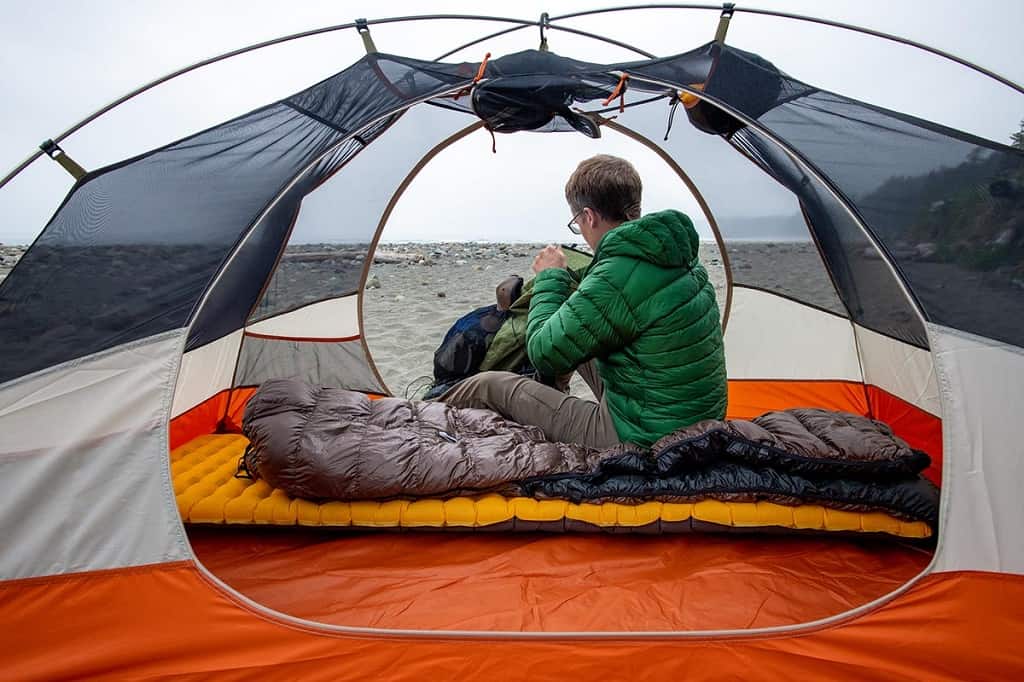Sleeping pads are essential while camping or backpacking. It provides insulation, comfort, and support, resulting in a higher quality of sleep.
If you need help on what to pack for trekking then click here.
A sleeping pad is a vital addition to any survival kit. Not only will it help insulate you from the uneven and often rocky ground, but it will also give you an excellent surface to rest your weary head after a long day of hiking and trekking.
Sleeping pads keep your body warm and protect you from the ground’s moisture. It gives you a soft place to rest so that you don’t wake up with a sore back.
A sleeping pad of any variety is essential for a good night’s sleep in the outdoors. Choosing the right pad can be difficult.
What kind of sleeping pad you choose will depend on several factors, including how comfortable you are with being confined to your sleeping bag for the night, how long you are willing to carry it, and how much you are ready to spend. The right sleeping pad can make a massive difference to your trip.
Generally speaking, there are four types of pads: air pads, self-inflating pads, foam pads, and closed-cell foam pads. Pads have different intended uses: some are designed more for insulation, while others feature a thicker cushioning to support joints or provide extra padding from cold ground or rocks.
Sleeping pads: Types
For longer backpacking trips and camping trips in the winter, there are four main types of sleeping pads you can choose from: Air pads, Self-inflating pads, Closed-cell pads, and Foam pads.
1. Air Pads
Air Pads are very light and portable but don’t maintain heat as well. Plus, they are highly prone to punctures from sharp objects on your backpack, so you need to be more careful. If you are hiking in hot weather or carrying a heavy load, an air pad may be best for you.
Nemo Roamer Double Sleeping Pad, EXPED MegaMat Max Duo 15 Sleeping Pad are our favorites.
2. Self-Inflating Pads
These are the lightest type of pad and are the easiest to use. They are a hybrid of air and foam pads.
Self-inflating pads can be folded in half for storage and offered as a convenient carry-on bag for backpackers. You inflate them by blowing into a valve on the side of the pad.
Manual inflation pads are also a great way to get the perfect cushioning level under you without any fuss. They’re an excellent choice for people who don’t like using an electric pump because they are fuss-free. Simply unroll the pad onto your tent or sleeping bag and get to sleep. If you don’t blow into the valve, you will have to pump air into the pad manually.
EXPED MegaMat Max Duo 15 Sleeping Pad and Therm-a-Rest Trail Pro™ Sleeping Pad are some of the best Self-inflating pads.
3. Closed-cell pads
Closed-cell pads are made of a foam material compressed and then heated under pressure.
This process produces a dense, rigid core with a uniform cell structure. The resulting foam is generally more expensive than are usually heavier than air pads, but they provide better insulation and are incredibly durable.
Closed-cell pads also tend to be more comfortable than air pads, as they give more cushioning. However, they are bulkier and don’t pack down as small as air pads.
4. Foam pads
Foam pads are a cushioning device designed to distribute one’s body’s weight over an even surface. They are cheap and offer more durability than self-inflating pads, but they can be bulky and heavy to carry.
They’re also much more challenging to clean than self-inflating pads.
Nemo Roamer Double Sleeping Pad and Nemo Roamer Double Sleeping Pad are our favorite foam pads.
Click here to check out more variety on sleeping pads.
Sleeping pads: How to choose the best one for you?
Your sleeping pad is crucial when backpacking or camping in the winter, but even more important if you plan to sleep out at night in sub-freezing temperatures.
A sleeping pad is a must for any winter camping trip. Even if you are a very cold sleeper, you will notice that your sleeping bag is doing all the work.
If you hear that creak in your sleeping bag, don’t worry; it’s just your body adjusting to the temperature (it’s okay).
Before you choose what type of sleeping pad you want, you must consider particular factors such as:
1. Where you are going and the place’s weather
One of the first things you’ll want to consider when choosing a sleeping pad is where you plan on going.
Even if you are traveling just down the road, you can use this same basic information as a starting point. The terrain and climate will affect not only your choice of the pad but also the clothes or sleeping bag that will keep you warm.
For instance, if you will be traveling in the mountains, your pad should have a high R-value. It means that it will keep you warm throughout the night because its insulation will retain heat much better than a low R-value pad would. An insulated sleeping pad is also essential if you are hiking in cold weather or snow.
2. Insulation and R-Value
Okay, you have heard too much about insulation and R-value. Let me tell you what it means.
The most important aspect of a sleeping pad is insulation. The first factor to consider is the intended conditions. Is this going to be a backpacking trip or a camping trip, and what kind of weather will you be facing? Researching your destination can help you determine which type of insulation best fits your needs for warmth and comfort.
It’s also imperative to note the temperature rating on sleeping pads, as they can vary significantly from one manufacturer to another.
Think of this as the amount of heat that the pad will keep you warm. The main thing to consider is how cold it gets where you will be hiking to estimate what type of insulation you will need. An air pad will have a very low R-value, meaning that it won’t keep you warm.
If you are going to be sleeping in cold weather, you should invest in a high R-value. But if you are going to be using the pad for hot weather, consider just the weight and space it will take up in your pack.
Sleeping pad insulation is a crucial consideration when it comes to your night’s comfort. It is vital to have a sleeping pad with sufficient insulation for the temperature you expect to encounter. The most common way to rate sleeping pad insulation is in R-value, which quantifies thermal resistance.
- What is R-Value?
The R-value of a sleeping pad means its capacity to retain the heat flow through it.
The higher the R-value, the warmer a pad will be. A higher R-value indicates more excellent insulation and, therefore, less heat loss from your body into the ground.
To calculate your own R-value, you simply take the pad’s insulation value (Listed in inches of R-7), divide it in half, and then multiply that number by 2.5. For example, a pad with an insulation value of 20″ R-4 would be 28/2.5 = 9″ thick, so you would multiply 28/2.5 = 9″, which is 3″. So this pad would have an R-value of 3.
Many manufacturers now list the R-value of their sleeping pads on the label. Choosing a sleeping pad with a higher R-value will keep you warmer at night and is especially important if you sleep cold or live in a low latitude (for example, Northern Canada).
3. Weight
Another most crucial factor to consider when choosing your sleeping pad is how much it weighs. Pads are designed to store heat water in, so they can be heavy and awkward to carry. With that in mind, the lighter your pad, the lower your pack weight will be.
If you will be backpacking, then light is always best and will save you on your energy levels and your back when carrying it. But you also must know that the type of pad determines the weight and the size. The selection depends on what sort of trip you are taking, but a general rule is that the lighter it is, the less robust it will be and vice versa.
A self-inflating pad will weigh around 20 ounces (approximately) whereas, a closed-cell pad will weigh about 2 pounds. Air pads will be anywhere between the two.
4. Shapes
The next consideration will be the shape of the pad. As a general rule, the longer and thinner you go, the lighter your pad will be, but also the more likely it is to roll up on you while you sleep.
Paddle-shaped pads are popular because they are wider in the middle and narrow at both ends – making them more comfortable to sleep on by giving your elbows space to rest on. If you are looking for more padding, try something more like an egg-shaped pad.
5. Sizes
Another thing to consider is how large or small the pad is. If you are hiking with a lot of gear, you may want to consider getting a smaller or thicker pad.
If you are going somewhere with particularly harsh terrain, you may want to go with a thicker sleeping pad or one that has some extra cushioning. Its temperature rating should be LOWER than the R-value of your pad – this will help keep you warm throughout the night.
6. Opt for Down instead of Synthetic
The price and weight difference between down and synthetics make it worth spending the extra money on a quality down bag.
Downs are typically lighter, more compressible, and more breathable, which lets you stay more relaxed at night. You’ll find that they are also more versatile than their synthetic counterparts when it comes to shedding water effectively. They also insulate better than synthetic material at temperatures under 32 °F.
7. Modern Technology
Ensure that you keep up with the latest sleeping bag technology and get manufactured with modern ergonomics in mind. It will make it easier to sleep on your stomach or side, as well as reduce the chances of overheating from staying in the bag too long without moving around.
A new type of synthetic fiber called Capilene is trendy right now because it is more breathable and provides better thermal regulation than older synthetic fibers. These fibers are also less expensive than down and are a good option for those on a tight budget. What’s more, they don’t lose their warmth when wet.
Also, learn how to pick the right trekking poles for your trek here.
Sleeping Pads: Additional Tips
- Insulate your sleeping bag with help from your sleeping pad. It will keep you warm all night long. When it’s cold outside, your body generates a lot of heat. If you put a layer of insulation between your body and the pad, it will not be able to insulate you as well.
- Before going to bed, make sure to spend at least 5 minutes lying on your pad. It will help the body adjust to the temperature so you won’t feel cold when you get out of the sleeping bag later.
- For clothing, choose specialty fabrics that are designed for winter camping. If you are a more heat-intolerant person, make sure that your clothes have an adequate amount of synthetic insulation or wool. Some tops are designed to wick moisture away from your body, so this will keep you dry, and it will also help avoid overheating.


